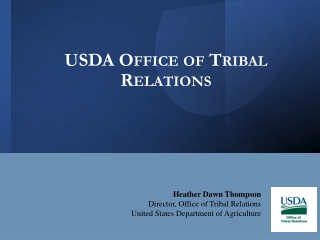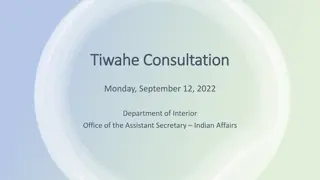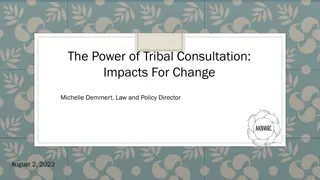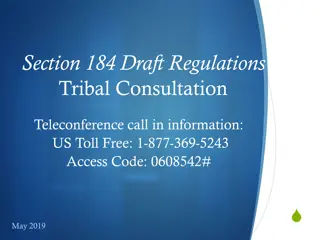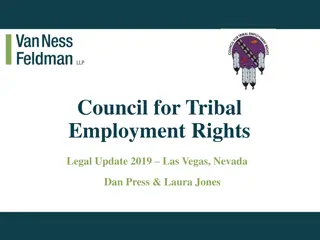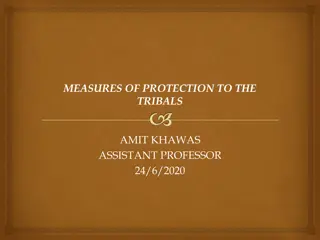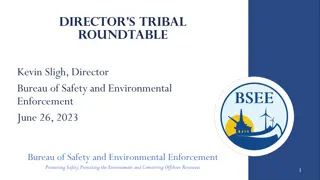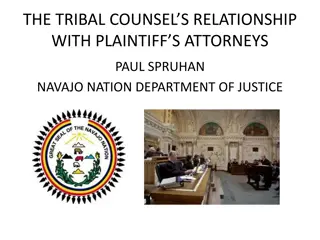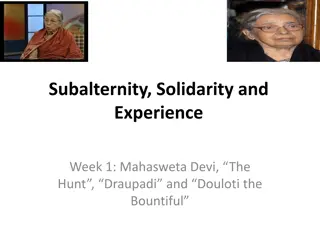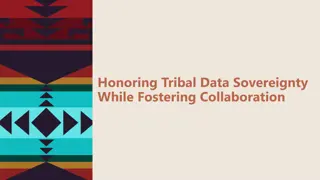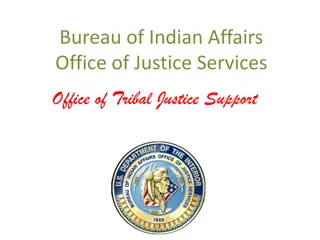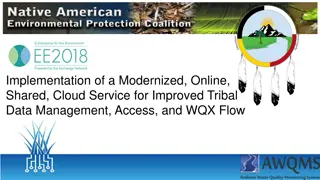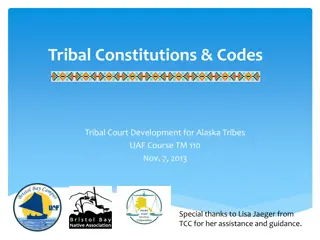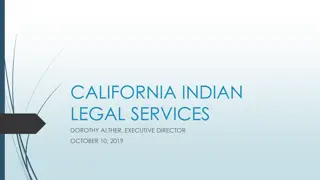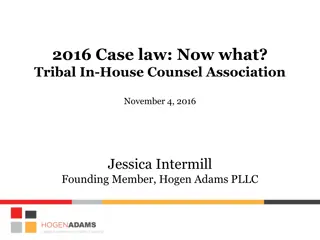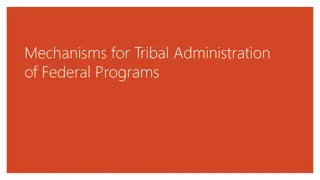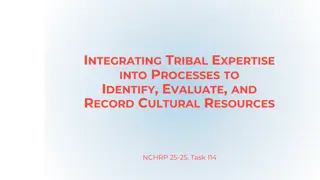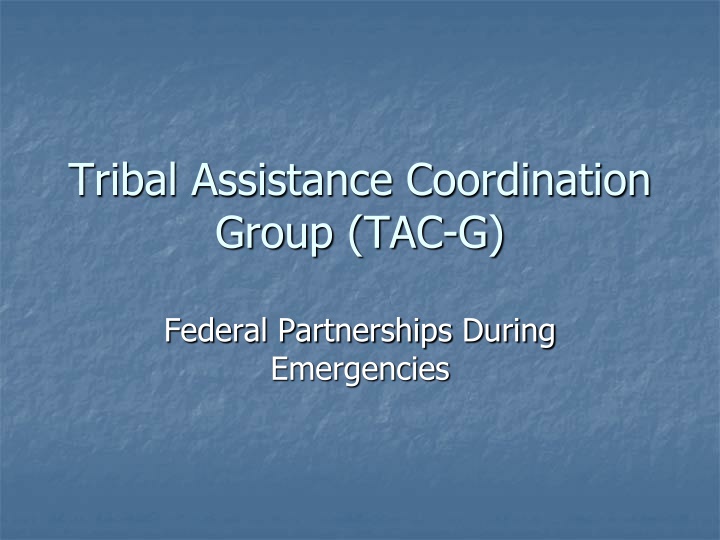
Tribal Assistance Coordination Group (TAC-G) and Federal Emergency Partnerships
The Tribal Assistance Coordination Group (TAC-G) facilitates partnerships between federal agencies like Indian Affairs, Indian Health Service, and FEMA to enhance emergency response in tribal communities. The Office of Homeland Security & Emergency Services (OHSES) plays a key role in coordinating activities related to emergency preparedness and response, including Continuity of Operations Plans, National Response Framework, and pandemic flu preparedness. The structure within Indian Affairs and Indian Health Service is detailed, showing the allocation of personnel for emergency management tasks.
Download Presentation

Please find below an Image/Link to download the presentation.
The content on the website is provided AS IS for your information and personal use only. It may not be sold, licensed, or shared on other websites without obtaining consent from the author. If you encounter any issues during the download, it is possible that the publisher has removed the file from their server.
You are allowed to download the files provided on this website for personal or commercial use, subject to the condition that they are used lawfully. All files are the property of their respective owners.
The content on the website is provided AS IS for your information and personal use only. It may not be sold, licensed, or shared on other websites without obtaining consent from the author.
E N D
Presentation Transcript
Tribal Assistance Coordination Group (TAC-G) Federal Partnerships During Emergencies
TAC-G Primary Partners Indian Affairs OHSES (BIA & BIE) Indian Health Service (IHS) FEMA (National Tribal Liaison)
Indian Affairs Office of Homeland Security & Emergency Services
History of OHSES 2001 Emergency Coordinator Position established in ASIA 2002 Homeland Security Position established in BIA (Position was under BIA-OJS) 2003 Homeland Security Position realigned in ASIA 2006 Office of Homeland Security and Emergency Services established
Office Activities Continuity of Operations Plans (COOP) National Response Framework (NRF) Tribal Annex & ESF #15 Pandemic Flu Preparedness National Preparedness System (NPS) Integrated Planning System (IPS) & Comprehensive Preparedness Guide (CPG) Implementation Federal Communication Commission (FCC) Coordination Government Emergency Telecommunications Service (GETS) & Wireless Priority System (WPS)
Office Activities (cont) National Infrastructure Protection Plan (NIPP) Tribal Assistance Coordination Group (TAC-G) Tribal Information Sharing Environment (ISE) Coordination of National Incident Management System (NIMS) & ICS Requirements Coordination and support of Ancillary Essential Support Functions (ESF)
Indian Affairs EM Structure AS-IA has two personnel for EM (All Fed mandates plus everything else) BIA 12 Regional Emergency Management Coordinators (Collateral duty assignment) BIE has three School Safety Specialists assigned to the Associate Deputy Directors *(Two hired one position to be filled)*
Indian Health Service 12 Area Emergency Management Points of Contact (EMPOCs) Positions are collateral duty assignment
FEMA Tribal Liaisons One for most FEMA Regions and a National Tribal Liaison Only National and Region IX are full time Tribal Liaisons positions
Challenges for Tribal Governments 90% of emergencies/disasters that affect Tribal Governments will not receive a Presidential Emergency and/or Disaster Declaration Many Federal Departments and Agencies do not have clear policies regarding emergency assistance to Tribal Governments with a PED/PDD Federal D&As don t always have the necessary reimbursable agreements in place pre-disaster
Overcoming the Challenges Establishing good working relationships prior to a disaster can make all the difference in how much assistance can be offered and available from Federal partners when your need is greatest. MOUs/MOAs are the best way to help insure the requested assistance/resources are available during an emergency
Why the TAC-G Poor Communication during response to Katrina and Rita Began with a meeting to get IA, IHS and FEMA communicating and coordinating response efforts (BP) First significant success during Ike and Gustav
Tribal Assistance Coordination Group (TAC-G) The TAC-G defines how Indian Affairs (IA), the Indian Health Service (IHS), and the Federal Emergency Management Agency (FEMA) intend to operate within during a disaster or emergency. Provides strategic guidance and operational context to work within an interagency framework that supports the National Incident Management System (NIMS) and respects the application of the National Response Framework (NRF). It also reinforces support of Emergency Support Function (ESF) #15 and the NRF Tribal Annex.
Tribal Assistance Coordination Group (TAC-G) con t The TAC-G ensures coordination with tribal governments on all aspects of incident management operations and provides a mechanism to work closely with DHS to ensure tribal relations actions are carried out in accordance with established Federal Government policies and procedures. Current Partners include: Indian Affairs, IHS, FEMA, DOI, ACF, HUD, DHS , USDA
New Partners DHS Office of Emergency Communication USCG FEMA Mitigation Directorate National Archives and Records Administration
TAC-G Charter Establishes a representative from all Executive Branch Departments and Agencies (Be careful what you wish for) Creates a Tribal Advisory Group
2010 Incidents Navajo Nation Snow Emergency Cheyenne River severe weather Los Coyotes Radio Issues Rocky Boy s flooding Deepwater Horizon Incident
Regional Emergency Management Workshops BIA and IHS are partnering to present emergency management workshops beginning in 2011 to engage regional Federal D&A representatives The workshops will have tracks for BIA and IHS personnel as well as tribal emergency management personnel A combined open forum will be conducted at the end of the workshop
Questions? Patrick Vacha Indian Affairs Emergency Management Coordinator 202-208-4438 Office 202-577-5918 Mobile patrick.vacha@bia.gov

